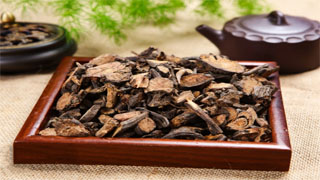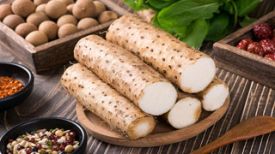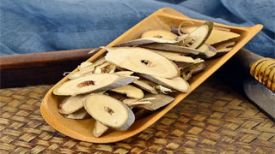
1. Aliases
Mahu jujube, Mian Di Yu, Cucumber fragrance, Bai Di Yu, Xi Di Yu.2. Plant morphology
Perennial herbaceous plant, 30-120 centimeters tall. The root is thick and robust, mostly spindle shaped, with a sparse cylindrical shape. The surface is brownish or purplish brown, and the cross-section is yellow white or purplish red. The stem is upright, angular, hairless or sparsely glandular hairy at the base. Basal leaves are feathery compound, with 4-8 pairs of leaflets, ovate or oblong ovate, 1-7 centimeters long and 0.5-3 centimeters wide. The apex is blunt, sparse, and acute, with a base heart-shaped to slightly heart-shaped. The edges have thick, large, blunt, sparse, and acute serrations; The stem leaves are small and nearly sessile; Basal leaves with membranous stipules, stem leaves with large stipules, herbaceous, semi ovate, and sharp serrated outer edges. Spike inflorescences are elliptical, cylindrical, or ovoid, with a length of 1-3 centimeters; Bracts 2; Sepals 4, purple red; 4 stamens, nearly equal or slightly shorter than sepals; The top of the stigma is enlarged, disc-shaped, with fringe shaped nipples at the edges. Achenes are enclosed within the calyx and have 4 edges on the outside. The flowering and fruiting period is from July to October.
3. Origin distribution
Born in grasslands, meadows, mountain grasslands, shrubs, and sparse forests. Distributed throughout the country. Mainly produced in northwest and northeast regions.
4. Harvesting and processing
Harvest during spring when sprouting or autumn when plants wither, remove fibrous roots, wash, dry, or slice while fresh, dry.
5. Characteristics of medicinal herbs
Irregular spindle or cylindrical shape, slightly bent or twisted, 5 to 25 centimeters long, with a diameter of 0.5 to 2 centimeters. The surface is grayish brown, brownish brown, or dark purple, rough, with longitudinal wrinkles, transverse cracks, and branching marks. Hard in texture, with a relatively flat cross-section, pink or light yellow in color, and gray brown or light yellow in wood, slightly arranged radially. Slice irregularly circular or elliptical, with a thickness of 0.2-0.5 centimeters; Cut purple red or brown in color. Odorless, with a slightly bitter taste.
6. Nature, taste, and meridian tropism
Mildly cold in nature, with a bitter, sour, and astringent taste. Guigan Meridian and Large Intestine Meridian.
7. Effect and function
Cool blood, stop bleeding, detoxify and restrain sores. A cooling and hemostatic medicine that belongs to the subcategory of hemostatic drugs.
8. Clinical applications
Dosage 9-15 grams, decoct in water, apply an appropriate amount externally, grind and apply to the affected area. Used to treat bloody stools, hemorrhoids, dysentery, metrorrhagia, scalds caused by water and fire, as well as carbuncle and sore toxins.
9. Pharmacological research
Pharmacological research has a hemostatic effect, which can reduce wound exudate, resist infection, and facilitate the healing of scalded wounds. In addition, it also has antihypertensive, antiemetic, therapeutic effects on acute liver injury, and hemolysis induced by antioxidant hydrogen.
10. Chemical composition
Containing Diyu glycoside I, gallic acid, Diyu extract, 1,2,6-trigaloyl - β - D-glucose, Diyu glycoside II, and aglycone 19- α - hydroxy ursolic acid. In addition, it contains components such as glycosides from Rehmannia officinalis, quercetin-3-galactose-7-glucoside, kaempferol, quercetin, Rehmannia officinalis saponin A, Rehmannia officinalis saponin B, Rehmannia officinalis saponin E, glycoside ursolic acid, and catechins.
11. Taboos for use
Harmful to the stomach, often ingested by mistake, resulting in mouth numbness and loss of appetite. Patients with spleen and stomach deficiency and cold, sinking of middle qi, cold dysentery and diarrhea, collapse and leakage, and blood deficiency and stasis should take medication with caution.
12. Compatibility prescription
Treatment of scalding and fire injury: Urgently use ground elm oil as if on the face, apply sesame oil, and the pain will stop immediately; If the blister has already formed, it should be punctured to release toxic water, then applied, and then sprinkled with dry powder. The same applies to those who are damaged. (Complete Book of Surgical Diagnosis and Treatment)
② Treatment for gastric ulcer bleeding: 9g raw elm, 15g octopus bone, 6g woody incense. Boiled in water. (Ningxia Chinese Herbal Medicine)
③ Treatment for primary thrombocytopenic purpura: 30g each of Sanguisorba officinalis and Panax notoginseng, or 30g of Achyranthes bidentata added, decoction in water, continuous for 2 months. (Selected Compilation of National Exhibition on New Traditional Chinese Medicine Therapy Materials)
④ Treatment of traumatic bleeding: Grind fine powder of Diyu charcoal and apply it externally to the affected area. Alternatively, it can be paired with madder, white ginger, and Scutellaria baicalensis for external use after grinding. (Selected Chinese Herbs from Shaanxi Gansu Ningxia Qing)
⑤ Under the treatment of red and white discharge: 60g of ground elm, 1 liter of rice vinegar, boil for more than ten times to remove impurities, and take a hot drink before eating. (Hygiene Simplified Formula)
The content of the article is for clinical reference only. Non professionals in traditional Chinese medicine are not allowed to try medication.


